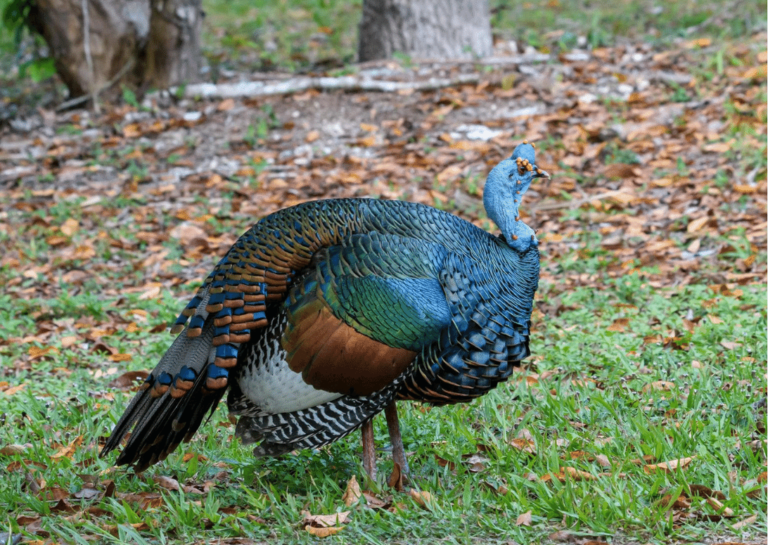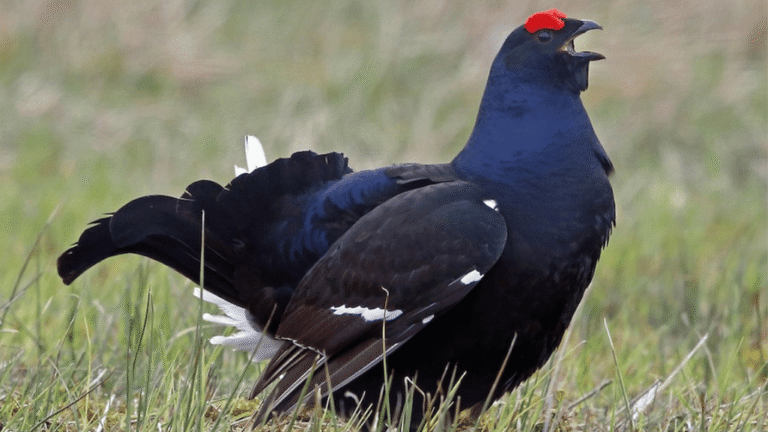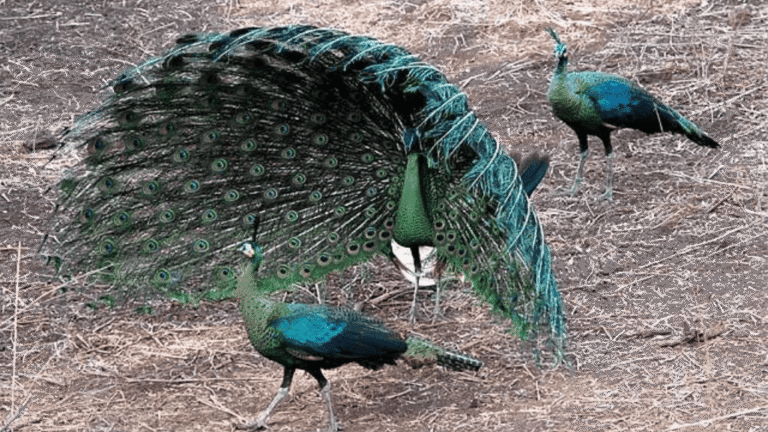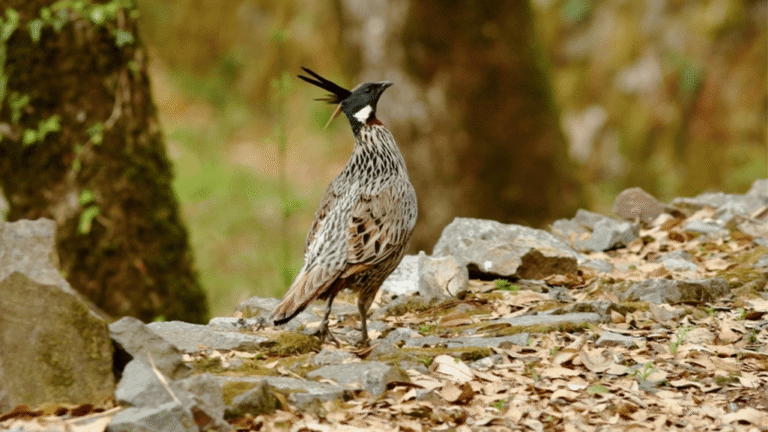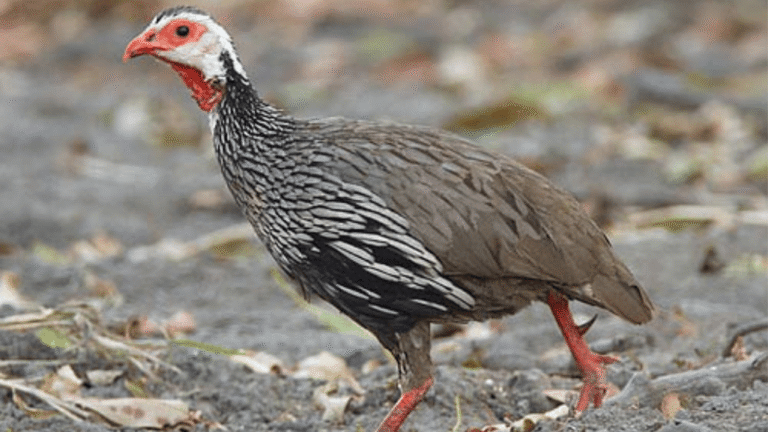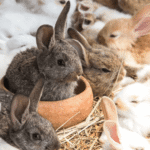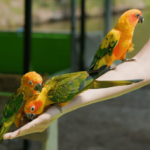The Palawan Peacock-Pheasant, scientifically known as Polyplectron napoleonis, is a rare and endangered bird species native to the island of Palawan in the Philippines. Known for its vibrant plumage and unique courtship displays, this magnificent bird attracts birdwatchers and wildlife enthusiasts from around the world. Its conservation is crucial for preserving the rich biodiversity of Palawan and protecting this iconic bird species.
Birdwatching in Palawan offers a unique opportunity to observe the Palawan Peacock-Pheasant in its natural habitat, contributing to wildlife conservation efforts and raising awareness about the importance of preserving endangered species. The stunning beauty of this bird also makes it a favorite subject for bird photography, allowing photographers to capture its enchanting presence.
Key Takeaways:
- The Palawan Peacock-Pheasant is an endangered bird species endemic to Palawan in the Philippines.
- Its vibrant plumage and unique courtship displays make it a fascinating subject for birdwatching and photography.
- Conservation efforts are crucial for preserving the Palawan Peacock-Pheasant and the biodiversity of Palawan.
- Birdwatching and photography provide opportunities to observe and document this rare bird species.
- By actively participating in conservation initiatives, we can contribute to the long-term survival of the Palawan Peacock-Pheasant and the ecological balance of Palawan.
The Magnificent Plumage of the Palawan Peacock-Pheasant
The Palawan Peacock-Pheasant, scientifically known as Polyplectron napoleonis, exhibits a truly magnificent plumage. The male Palawan Peacock-Pheasant is adorned with a stunning combination of blue, green, and black feathers. These feathers feature intricate patterns and eye-like spots, creating a mesmerizing display of colors. During courtship displays, the male spreads its tail feathers wide, forming an impressive fan-like shape that aims to attract the attention of females.
The female Palawan Peacock-Pheasant, while more subdued in comparison to the males, possesses its own unique beauty. Its plumage showcases subtle yet beautiful markings, complementing the overall aesthetic of the species.
The distinct plumage of the Palawan Peacock-Pheasant sets it apart as a visually captivating bird species. These remarkable feathers serve as both a display of vitality and an integral part of the courtship ritual, allowing males to showcase their genetic fitness to potential mates.
The Unique Characteristics of the Palawan Peacock-Pheasant
The Palawan Peacock-Pheasant, scientifically known as Polyplectron napoleonis, is an endemic species found exclusively on the island of Palawan in the Philippines. This stunning bird has unique characteristics that contribute to its vulnerability and the need for conservation efforts.
Habitat
The Palawan Peacock-Pheasant inhabits lowland forests, which provide the ideal environment for its survival. These forests offer the necessary resources, including food and shelter, for the bird’s well-being. Over time, the Palawan Peacock-Pheasant has adapted to the specific habitat conditions of Palawan, making it highly specialized and dependent on these forests for its existence.
Diet
The diet of the Palawan Peacock-Pheasant consists of a variety of foods that are essential for its nutrition. Fruits, seeds, insects, and small invertebrates constitute the primary sources of sustenance for this magnificent bird. Its diverse diet reflects its adaptability to forage in different layers of the forest, promoting its survival and overall fitness.
| Unique Characteristics of the Palawan Peacock-Pheasant | Description |
|---|---|
| Endemic Species | The Palawan Peacock-Pheasant is found only on the island of Palawan, making it unique to this region. |
| Precise Habitat Requirements | This bird requires the presence of lowland forests on Palawan to meet its habitat requirements. |
| Diet Variation | The Palawan Peacock-Pheasant is an omnivorous bird, consuming fruits, seeds, insects, and small invertebrates. |
| Habitat Dependency | Due to its specialized habitat requirements, the Palawan Peacock-Pheasant is vulnerable to habitat loss and degradation. |
Conservation of the Palawan Peacock-Pheasant
The Palawan Peacock-Pheasant, also known as Polyplectron napoleonis, is currently facing severe threats to its survival due to habitat loss from deforestation and illegal logging, as well as poaching for the bird trade. It is crucial to implement conservation measures to protect this endangered species and preserve its natural habitat in Palawan, Philippines.
Various conservation organizations and government agencies are actively working together to establish and manage protected areas specifically dedicated to the conservation of the Palawan Peacock-Pheasant. These protected areas aim to safeguard the bird’s habitat, ensuring its long-term survival, and raising awareness about the species’ importance in the local ecosystem.
In addition to protected areas, the involvement of local communities is vital in the conservation efforts. By engaging and educating local residents about the significance of the Palawan Peacock-Pheasant, sustainable land-use practices can be promoted, reducing the impact of human activities on the bird’s habitat.
To highlight the importance of conservation, a summary and visualization of the threats faced by the Palawan Peacock-Pheasant are presented in the table below:
| Threats | Impact |
|---|---|
| Deforestation and illegal logging | Loss of habitat, disruption of food sources, and nesting sites. |
| Poaching for the bird trade | Reduces the population size, disrupts breeding patterns, and threatens the species’ survival. |
This visualization emphasizes the need for immediate conservation efforts to combat these threats and secure the future of the Palawan Peacock-Pheasant.
By prioritizing the conservation of this magnificent bird species and its habitat, we can contribute to the preservation of the rich biodiversity found in Palawan and uphold the Philippines’ commitment to wildlife conservation.
Birdwatching and Ecotourism in Palawan
Palawan is a haven for birdwatching enthusiasts, offering a unique opportunity to explore its rich avian biodiversity. With its stunning landscapes and diverse ecosystems, Palawan is home to many unique bird species, including the magnificent Palawan Peacock-Pheasant. Birdwatchers from around the world flock to the island to catch a glimpse of these fascinating creatures and immerse themselves in the wonders of nature.
Palawan boasts several nature reserves and protected areas that provide ideal habitats for a wide variety of bird species. These pristine locations offer birdwatching enthusiasts the chance to observe and photograph a diverse range of birds, including the elusive Palawan Peacock-Pheasant. Guided by local experts, visitors can embark on thrilling excursions through lush forests, wetlands, and coastal areas, where they can witness the vibrant birdlife that inhabits the island.
Birdwatching tourism not only provides an unforgettable experience for visitors but also contributes to the local economy and supports conservation efforts. The influx of tourists creates opportunities for sustainable ecotourism initiatives, generating income for local communities and fostering the preservation of Palawan’s natural treasures. By engaging in birdwatching activities, visitors become active participants in the conservation of these unique bird species and contribute to the overall protection of Palawan’s delicate ecosystem.
Palawan’s Nature Reserves and Protected Areas
Here are some of the notable nature reserves and protected areas in Palawan that offer exceptional birdwatching opportunities:
- Palawan Wildlife Rescue and Conservation Center (PWRC): Situated in Puerto Princesa, PWRC is a renowned wildlife conservation facility that shelters various bird species, including the Palawan Peacock-Pheasant. Visitors can observe these magnificent birds up close and learn about the ongoing conservation efforts.
- Tubbataha Reefs Natural Park: A UNESCO World Heritage Site, Tubbataha Reefs Natural Park is famous for its stunning coral reefs and diverse marine life. It is also a sanctuary for seabirds, making it a prime birdwatching destination.
- El Nido Marine Reserve: This marine reserve is known for its breathtaking limestone cliffs and crystal-clear waters. Aside from its vibrant marine ecosystem, El Nido is an ideal spot to observe coastal bird species, including herons, egrets, and kingfishers.
- Crocodile Farm and Nature Park: Located in Puerto Princesa, the Crocodile Farm and Nature Park is not only home to crocodiles but also serves as a sanctuary for numerous bird species. Birdwatching enthusiasts can explore the park’s lush surroundings and spot various avian wonders.
Palawan’s nature reserves provide a safe haven for birds and offer visitors a chance to witness the island’s exceptional avian biodiversity. These protected areas are essential for the long-term conservation of Palawan’s unique bird species, including the magnificent Palawan Peacock-Pheasant.
| Nature Reserve | Location | Bird Species |
|---|---|---|
| Palawan Wildlife Rescue and Conservation Center (PWRC) | Puerto Princesa | Palawan Peacock-Pheasant, various other bird species |
| Tubbataha Reefs Natural Park | Off the coast of Puerto Princesa | Seabirds, including various species of boobies and frigatebirds |
| El Nido Marine Reserve | El Nido | Coastal bird species such as herons, egrets, and kingfishers |
| Crocodile Farm and Nature Park | Puerto Princesa | Various bird species |
The Role of Photography in Capturing the Beauty of Palawan Peacock-Pheasant
Photographers play a crucial role in capturing the beauty of the Palawan Peacock-Pheasant and raising awareness about its conservation. Through bird photography, they can document the unique features, behavior, and habitat of the bird, showcasing its importance in the ecosystem.
Wildlife photographers also contribute to biodiversity conservation by promoting the protection of endangered species like the Palawan Peacock-Pheasant through their captivating images. The stunning plumage and courtship displays of the bird make it a favorite subject for photographers seeking to capture the essence and allure of Philippine wildlife.
By capturing these images, photographers give people a glimpse into the beauty and fragility of the natural world, inspiring them to take action to protect and conserve our planet’s biodiversity. Through their visual storytelling, photographers can evoke emotions and create connections between viewers and the Palawan Peacock-Pheasant, fostering a sense of empathy and urgency for its conservation.
Furthermore, photographers can actively contribute to ongoing conservation efforts by sharing their images with conservation organizations, educational institutions, and the general public. These images can be used for environmental education, awareness campaigns, and fundraising initiatives, all of which contribute to the overall conservation of the Palawan Peacock-Pheasant and its habitat.
The Photographer’s Perspective
From a photographer’s perspective, capturing images of the Palawan Peacock-Pheasant requires patience, skill, and an understanding of the bird’s behavior and habitat. Photographers must spend time researching and studying the bird’s habits, identifying the best locations and times of day to capture stunning images.
They need to navigate the challenges of photographing in the bird’s natural habitat, dealing with factors such as low light conditions, foliage obstacles, and unpredictable bird movement. Wildlife photographers often spend hours or even days waiting for the perfect moment to capture a shot, immersing themselves in the bird’s world and gaining a deep appreciation for its beauty and vulnerability.
Through their photos, photographers aim to convey not only the visual appeal of the Palawan Peacock-Pheasant but also its ecological significance. By highlighting the bird’s role in the ecosystem and the threats it faces, photographers can advocate for its conservation and encourage viewers to take action.
The Importance of Biodiversity Conservation in Palawan
The conservation of the Palawan Peacock-Pheasant is crucial in the broader effort to protect the biodiversity of Palawan. Known as a hotspot for biodiversity, Palawan is home to numerous endemic species and unique ecosystems that require preservation. By focusing on safeguarding the habitats of threatened species like the Palawan Peacock-Pheasant, conservation efforts contribute to the overall health and resilience of the island’s ecosystems.
Biodiversity conservation in Palawan has several significant benefits:
- Promotes environmental preservation
- Supports sustainable use of natural resources
- Preserves unique and endemic species
- Ensures the long-term survival of threatened species
- Contributes to scientific research and education
The Palawan Peacock-Pheasant, as an emblematic species, serves as a flagship for biodiversity conservation efforts. By conserving this threatened species, we help protect the delicate balance of Palawan’s ecosystems and maintain its natural heritage for future generations.
| Benefits of Biodiversity Conservation in Palawan | Description |
|---|---|
| Promotes Environmental Preservation | Conservation efforts help maintain the integrity of Palawan’s ecosystems, ensuring clean air, water, and a healthy environment for both wildlife and human communities. |
| Supports Sustainable Use of Natural Resources | By preserving biodiversity, we can manage natural resources more efficiently, promoting sustainable practices that benefit local communities and the economy. |
| Preserves Unique and Endemic Species | Conservation efforts protect the diverse range of unique plants and animals found only in Palawan, preserving their genetic diversity and ecological value. |
| Ensures the Long-term Survival of Threatened Species | By focusing on conservation, we can prevent the extinction of threatened species like the Palawan Peacock-Pheasant and maintain the delicate balance of the ecosystem. |
| Contributes to Scientific Research and Education | Research conducted on Palawan’s biodiversity provides valuable insights into ecosystem dynamics, helping us understand the interconnectedness of species and ecosystems. |
Conclusion
The Palawan Peacock-Pheasant, with its vibrant plumage and captivating courtship displays, is a remarkable bird species that represents the rich biodiversity of the Philippines, especially in Palawan. Unfortunately, this magnificent bird is facing serious threats to its survival, including habitat loss and poaching.
However, through dedicated wildlife conservation efforts supported by ecotourism and bird photography, we can help protect the Palawan Peacock-Pheasant and preserve the natural heritage of Palawan. By raising awareness about this endangered species and actively participating in conservation initiatives, we can ensure the long-term survival of this rare gem of Philippine wildlife.
Conservation organizations, local communities, and government agencies are working together to establish protected areas and promote sustainable land-use practices to safeguard the habitat of the Palawan Peacock-Pheasant. Additionally, birdwatching enthusiasts and photographers contribute to the cause by documenting the beauty of this bird and promoting its importance in the ecosystem.
By valuing the importance of biodiversity conservation and taking action to protect endangered species like the Palawan Peacock-Pheasant, we can make a positive impact on the fragile ecosystems of Palawan and contribute to the preservation of the Philippines’ natural heritage for future generations.
Frequently Asked Questions
What is the Palawan Peacock-Pheasant?
The Palawan Peacock-Pheasant, scientifically known as Polyplectron napoleonis, is a rare and striking bird species native to the island of Palawan in the Philippines. It is considered an endangered species.
Why is the Palawan Peacock-Pheasant endangered?
The Palawan Peacock-Pheasant is endangered due to habitat loss caused by deforestation and illegal logging, as well as poaching for the bird trade.
Why is birdwatching popular in Palawan?
Palawan is a popular destination for birdwatching enthusiasts because of its rich avian biodiversity and the presence of unique bird species such as the Palawan Peacock-Pheasant.
How can photography contribute to the conservation of the Palawan Peacock-Pheasant?
Photography plays a crucial role in capturing the beauty of the Palawan Peacock-Pheasant and raising awareness about its conservation. Photographers document the unique features, behavior, and habitat of the bird, promoting the protection of endangered species.
What is the importance of biodiversity conservation in Palawan?
Biodiversity conservation in Palawan is essential for preserving the rich natural heritage of the island. It supports the sustainable use of natural resources, promotes research and education, and ensures the long-term survival of threatened species like the Palawan Peacock-Pheasant.




